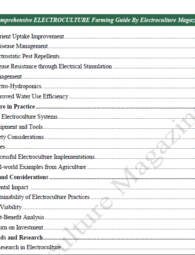Once again welcome to Electroculture Magazine. Learn more about the electrifying world of agriculture in our most recent post, “Electrostatics: An Electroculture Technique.” Learn how electrostatics is transforming agricultural methods, boosting crop yields, and advancing sustainable agriculture. This enlightening article has been carefully chosen by our team of experts to keep you informed of the most recent developments in electroculture. Join us as we explore the interesting nexus between agriculture and electricity on this exciting tour. Good luck with your reading and keep up with Electroculture Magazine!
What is Electrostatics?
The use of static electric charges in agricultural practises is referred to as electrostatics in electroculture. It’s a method for influencing plant development, increasing crop yields, and raising overall agricultural production. It involves the use of regulated electric fields. Electrostatics tries to improve the environment for plants and crops by adjusting the electrical charges around them.
Electrostatics in electroculture is based on the idea that electrical charges can affect how ions and other charged particles flow through soil and plant tissues. This may result in a number of positive outcomes, including greater water absorption, higher nutrient uptake, and increased plant resistance to pests and diseases.
- Cell division
- Photosynthesis
- Transpiration
- Transport of nutrients and water
Electroculture is a relatively new field of research, and there is still much that we do not know about the effects of electrostatics on plant growth. However, the results of a number of studies suggest that electrostatics has the potential to be a valuable tool for improving crop yields and plant health.
Buy Our Handcrafted Electroculture eBook Now…
Equipment required in Electrostatics
The equipment required for electrostatics in electroculture may include:
- Electrostatic generator: This is the central piece of equipment that generates the static electric charge. It can be a Van de Graaff generator, Wimshurst machine, or other devices capable of producing high-voltage static electricity.
- Electrodes: Conductive materials, such as metal plates or brushes, are used to transfer and distribute the electric charge to plants or the surrounding environment.
- Grounding system: To ensure safety and complete the electric circuit, a proper grounding system is essential. Grounding rods or plates are used to dissipate excess charges and prevent electric shocks.
- Plant applicators: Specialized applicators or wands are used to direct the static electric charge towards specific plants or areas of interest.
- Insulators: Certain parts of the equipment, like handles and supports, may be made of insulating materials to prevent the dissipation of the electric charge in unintended directions.
- Conductive solutions (optional): In some cases, conductive solutions may be used to enhance the transfer of electric charges to plants or soil.
- Safety equipment: Working with static electricity requires careful safety precautions. Personal protective equipment (PPE) such as gloves, goggles, and grounding straps should be used to protect operators from electric shocks.
- Monitoring devices (optional): Advanced electroculture setups may include sensors or monitoring devices to measure electric field strength and other relevant parameters.
Depending on the particular application, more equipment can be required in addition to the fundamentals. To regulate the environmental conditions, a growth chamber can be required, for instance, if plants are being grown in an electric field.
The equipment needed for electrostatics in the electroculture technique varies in price based on the particular application and the equipment’s quality. However, the fundamental tools may be reasonably priced. For about $500, you could buy a power supply, a high-voltage amplifier, and electrodes, for instance.
The unique application and the electric field’s characteristics determine the safety of electrostatics in the electroculture technique. However, electrostimulation is generally thought to be harmless for plants. To protect the plants, the electric field needs to be kept below a specified threshold.
Consult with a knowledgeable professional before utilising the equipment if you’re interested in employing electrostatics in electroculture to make sure you’re doing it properly and successfully.
Also Have a Look on This Amazing Electroculture Tools for Your Experiments...
procedure for Electrostatics
Implementing the electrostatics technique in electroculture requires careful planning and execution to ensure its effectiveness and safety. Here’s a general procedure to follow for electrostatics in electroculture:
- Understand Electrostatics in Agriculture: Familiarize yourself with the principles of electrostatics in agriculture, including how electric charges can influence plant growth, nutrient absorption, and other agricultural parameters.
- Select Appropriate Equipment: Choose the necessary equipment, such as an electrostatic generator, electrodes, grounding system, and any additional components based on the scale and requirements of your electroculture project.
- Site Preparation: Identify the target area where you will apply the electrostatics technique. Ensure the soil is adequately prepared and that plants are ready for treatment.
- Safety Measures: Prioritize safety. Inform all involved personnel about potential hazards and provide them with appropriate safety gear, such as gloves, goggles, and grounding straps.
- Install Grounding System: Set up the grounding system by placing grounding rods or plates in the ground. This will ensure the dissipation of excess charges and prevent potential shocks.
- Position Electrodes: Position the electrodes strategically around the plants or in the target area. The arrangement of electrodes may vary depending on the specific electroculture goals.
- Apply Electric Charge: Activate the electrostatic generator to create a static electric charge. The electric charge will be transferred to the plants or soil through the electrodes.
- Monitor and Adjust: Monitor the electric field strength and adjust the intensity and duration of the electric charge as needed. Carefully observe the plants’ response to the treatment.
- Record Observations: Keep detailed records of the electrostatic treatment, including the parameters used, the duration of treatment, and the observed effects on plant growth and health.
- Evaluate Results: After the electrostatic treatment, assess the impact on the plants and overall agricultural productivity. Compare the results with control groups or conventional farming practices.
- Iterate and Improve: Based on your observations, make any necessary adjustments to the electrostatics technique to optimize its effectiveness.
- Research and Stay Informed: Continue learning about advancements in electroculture and electrostatics to stay updated on best practices and potential improvements in the technique.
Here are some safety precautions that should be taken when using electrostatics in electroculture technique:
- The electric field should be kept below a certain level to avoid damaging the plants.
- The plants should not be exposed to the electric field for too long.
- The equipment should be properly grounded to prevent electrical shock.
- The plants should be monitored for any signs of damage.
Benefits of Electrostatics
Electrostatics in electroculture offers several potential benefits, making it an intriguing technique for enhancing agricultural practices. While ongoing research is necessary to fully understand and optimize its effects, some of the perceived benefits include:
- Increased Nutrient Uptake: Electrostatics may enhance nutrient absorption by plants. The electric charges applied can influence ion movement in the soil and plant tissues, leading to improved nutrient uptake and utilization by plants.
- Enhanced Water Absorption: The technique may facilitate water uptake by plants. Electrostatics can modify the water distribution in the soil and around plant roots, helping plants access water more efficiently, particularly in dry conditions.
- Improved Crop Yields: Electrostatics has the potential to increase crop yields. By promoting better nutrient and water absorption, plants may experience improved growth and productivity.
- Reduced Chemical Dependency: Electrostatics could lead to decreased reliance on chemical fertilizers and pesticides. By improving nutrient uptake and plant resistance to pests and diseases, farmers may reduce the need for chemical inputs.
- Sustainable Agriculture: With reduced chemical usage, electroculture could contribute to more sustainable agricultural practices. By promoting eco-friendly approaches, it may support long-term environmental health.
- Drought and Stress Resistance: Electrostatics may enhance plant resilience to environmental stresses, such as drought or temperature fluctuations, thereby improving crop survival under adverse conditions.
- Energy Efficiency: The technique may require less energy compared to other electrostimulation methods. Lower energy consumption contributes to its feasibility as a sustainable farming practice.
- Reduced Environmental Impact: By decreasing chemical inputs, electroculture may help reduce the environmental impact associated with conventional farming, such as soil and water pollution.
- Versatility and Adaptability: Electrostatics can be applied to various crops and agricultural settings, making it adaptable to different farming systems and regions.
- Potential Cost Savings: By improving crop yields and decreasing chemical usage, farmers may experience cost savings in the long run.

It’s essential to note that while electrostatics in electroculture shows promise, research is ongoing, and the technique may not be universally effective for all crops or environments. Appropriate experimentation, implementation, and adaptation to specific agricultural scenarios are necessary for optimizing the benefits of this technique. As with any innovative farming approach, it’s vital to combine electroculture with other sustainable practices to achieve the best results in modern agriculture.
Electroculture is a relatively new field of research, and there is still much that we do not know about the effects of electrostatics on plant growth. However, the results of a number of studies suggest that electrostatics has the potential to be a valuable tool for improving crop yields and plant health.
It is important to note that the benefits of electrostatics in electroculture may vary depending on the specific application and the equipment that is being used. It is always best to consult with a qualified expert before using electrostatics in electroculture.
Here are some of the limitations of electrostatics in electroculture technique:
- The effects of electrostatics on plant growth may vary depending on the type of plant, the environmental conditions, and the parameters of the electric field.
- The equipment required for electrostatics in electroculture can be expensive.
- There is still some uncertainty about the long-term effects of electrostatics on plant health.
Overall, electrostatics is a promising technique with the potential to improve crop yields and plant health. However, more research is needed to fully understand the effects of electrostatics on plant growth and to develop safe and effective methods for using electrostatics in agriculture.
Get Total Guidance From Electroculture Textbooks, Check This Out...































